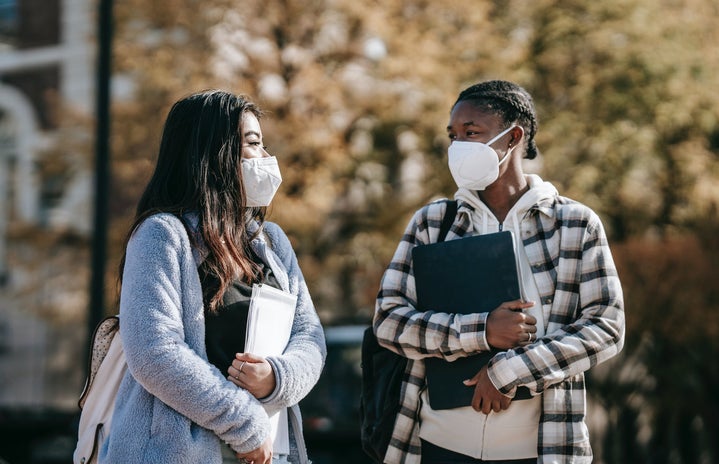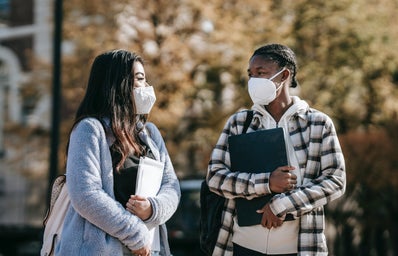At 8:30 AM, on Monday, for the first time since March 2020—almost exactly two years ago to the day—I walked into a classroom and sat down without wearing a mask. My professor and many of my classmates weren’t wearing masks either, so I finally saw the rest of their faces. (Some of which were not how I had imagined: surprise mustache, anyone?) My mouth, my nose, and the entire lower half of my face all felt too exposed, like I was sharing something private with my peers. I wasn’t quite sure how to hold my chin, and I realized that my full facial expressions were now on display to the professor–so I better look interested. I was also constantly conscious of the ten or so students in the class who were still wearing masks, hoping my choice didn’t make them uncomfortable. Throughout the hour and a half of class, I had to remind myself: this was how it was, before. This is supposed to be normal.
That March of two years ago feels distant beyond belief. All of my memories, now, are colored by masks. And beyond just preventing the spread of airborne illness, masks serve as a buffer between the wearer and the world. After almost two years of masking, going without feels like exposing a vulnerability, both to illness and to being fully seen by others. Our faces, which used to be how people knew us, have become much more private. I know people who don’t feel inclined to stop masking in public, ever, because they feel more comfortable keeping their faces to themselves, not on display to the whole world.
But even over the past few months, as masking policies have grown more lax in certain arenas–restaurants, the dorms, some gatherings—the classroom has been a stronghold. At the beginning of the semester, I could see no end in sight to the strict masking policies for in-person class. All of Brown’s modifications to COVID regulations up to that point had addressed testing, or recreational spaces, or the dining halls, but never the place we spend the most time in masks: in class. That is, until Thursday March 10, when Brown announced that masking would be optional in classes starting this week, in tandem with several other Ivy League schools.
The rule comes with a few important caveats: mainly, if the professor wants the class to continue wearing masks, they must. I don’t foresee the repeal of that rule anytime soon. There are many professors who understandably feel uncomfortable around unmasked students, which is unlikely to change, especially with new variants of COVID. One of my professors has asked us to keep the masks on. But the rest of my professors have taken off their masks and invited us to do the same. A few have also asked students to come talk to them if they’re uncomfortable attending class with the new rules. Professors, club coordinators, meeting hosts, and the like are all attempting to walk a fine social line—trying to make both the still-masked and the maskless students comfortable.
As for me, I’ve decided not to wear a mask in classes where I don’t have to, with the tentative exception of my large Applied Math lecture. Like almost all students at Brown, I’ve been triple vaccinated against COVID; I’ve also had COVID within the past few months. Of course, that doesn’t mean I or any of my peers won’t contract it again. With weekly testing now also optional, though, it’s unclear to me if isolation rules are still in place, or how people will even know they’ve been infected. The pandemic is certainly not “over,” and its continued presence and seriousness depend wildly on location in the world. At Brown, we are extremely lucky to attend school in a place with widespread vaccination and healthcare available to students
While it’s necessary to ponder the ramifications of the decision, I can’t leave out the excitement and relief that come with taking the mask off. It’s just in time for the first days of spring, when the rest of the layers start coming off, too. Goodbye to heavy coats, gloves, hats, and maybe even masks; the world is coming back to life! Two years after the nightmare began, it finally feels like the right time to begin stripping back regulations, rather than imposing more. We get to relearn what used to be our normal—one day, one decision, one face at a time.


